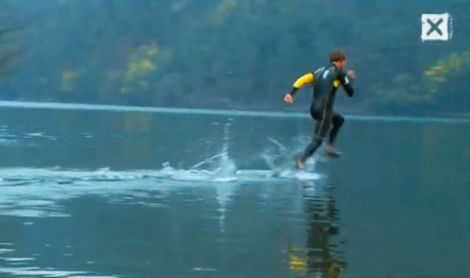Have you ever heard of ‘liquid mountaineering’? It was introduced in 2010 as a new extreme sport. After discovering an incredible pair of water repellant shoes, a group of athletes decided to try running on water. Like skimming a stone across the surface, the idea was to use tension, speed, and angle to cover as much distance as possible before falling into the water.
Millions of people learned about the sport via a YouTube video featuring a group of liquid mountaineers perfecting their sport in Gerês, Portugal. They manage to work their way up to eight to 12 steps on water before plunging in.
People loved it. Until they found out it was fake. After two weeks of international buzz, Hi-Tec, the makers of the water repellant shoes, came clean. During the initial buzz, they denied involvement in the making of the video, but then they rolled out a “making of” video showing exactly how they did it. It opens with an interview between the cameraman and one of the athletes:
“What are we doing here?”
“Selling the world a new sport.”
“Why?”
“Because the world needs something to believe in.”
Snake oil salesmen have been around for a long, long time. In recent years, the concept of fake news has entered our lexicon, but yellow journalism and propaganda have always been around, as has fake marketing.
Consider this sweet marriage proposal in Central Park, another video that went viral. Is it an ad for iPhones, people speculated? Could it possibly be real? I mean, who could coordinate such an elaborate proposal? And who would throw a diamond engagement ring across a pond? Turns out, Apple had nothing to do with it. But another company did – Thinkmodo, a company that specialized in the art and science of making viral videos. They used Frank’s Marriage Proposal in Central Park to launch their brand. Turns out, the couple, the proposal, the ring – all a marketing hoax.
Then, there was this brilliant video for international logistics giant, DHL. Advertising is expensive, so DHL hit on a way to get its competitors to advertise for them. Trojan Mailing involved print boxes with the message ‘DHL is Faster’, using (initially invisible) thermally-activated ink. Then, DHL shipped the boxes across the globe via competitor companies. Interestingly, this is one video that was not company-sponsored. It was a contest submission for an advertising award, created by German advertising agency Jung von Matt.
Just as it can be difficult to distinguish a cubic zirconia from a diamond or a really convincing Louis Vuitton knock-off from an authentic designer bag, it’s hard to tell what’s genuine in the media these days. Fake marketing and fake news. Sadly, they’re both real, but why are they so prevalent? I guess, as the liquid mountaineer said: “We all need something to believe in.” I just wish people believed more strongly in the pursuit of truth….
Fuel for Thought,
~Bob










